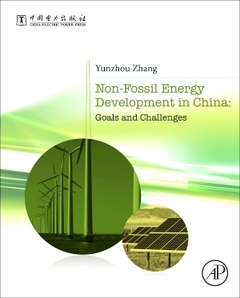Description
Non-Fossil Energy Development in China
Goals and Challenges
Coordinator: Zhang Yunzhou
Language: English
Subject for Non-Fossil Energy Development in China:
333 p. · 19x23.3 cm · Hardback
Description
/li>Contents
/li>Readership
/li>Biography
/li>Comment
/li>
Nonfossil Energy Development in China: Goals and Challenges explores the development of non-fossil energy sources, which is very important for China to protect its energy supply, deal with climate change and adjust its energy structure. At present, the development of energy and electricity is undergoing profound change. The core and most prominent feature is the sudden emergence of clean energy, exerting a decisive influence on the future energy industry.
Due to history and resource limitation, a series of problems in the energy development of China have existed for a long time, such as poor energy structure, serious environmental pollution, large carbon emissions, low energy efficiency, regional supply and demand imbalances. The Chinese government has set the development goal for nonfossil energy to 15% in primary energy consumption in 2020. The connotation and interpretation of the goal, possible development scenarios, feasible implementation paths, and corresponding benefit costs are all the major issues this book explains in detail and demonstrates by models.
1. Review and Outlook of World Energy Development 2. China’s Current Situation of Energy Development and Thinking on Future Development 3. Research Method and Model of Non-fossil Energy Development 4. Conditions and Exploitation Potential of Energy Resources 5. Construction and Comprehensive Evaluation of Non-fossil Energy Development Scenarios 6. Development of Power Grids and their Comprehensive Social and Economic Benefits 7. Implementation Path for the Goal of Non-fossil Energy Development 8. Policies and Measures for Implementing the Goal of Non-fossil Energy Development 9. Conclusions
Appendix I. Explanation of Main Statistical Indexes II. Technological and Economic Parameters for the Optimization of Power Supply III. Introduction to the Optimized Extension Model of Multi-zone Power Supply IV. Simulation Model of the Power System that Randomly Operates V. FM-based Analysis Model of the Power System VI. Computable General Equilibrium (CGE) Model VII. Quality Evaluation Index System of Energy Development Table A Table of World Energy Production and Consumption
Energy economics researchers, electric power system planning technicians of power utility, economists, university professors and students, consultants, and government policy makers in relevant fields.
- Demonstrates how to safely, economically and efficiently meet the Chinese government’s energy development target for non-fossil energy
- Analyzes energy development scenarios by using the energy demand and supply model, electricity demand forecasting model and power system optimization planning models
- Focuses on practical problems and algorithms
These books may interest you

World Energy Outlook 2015 150.00 €



